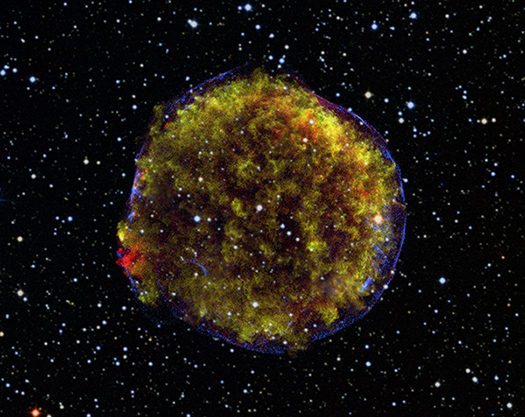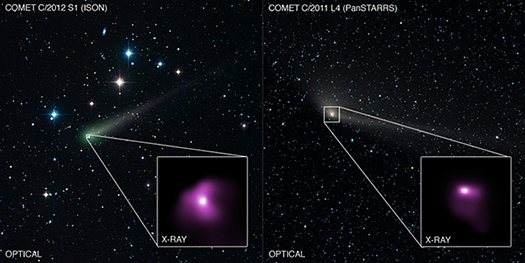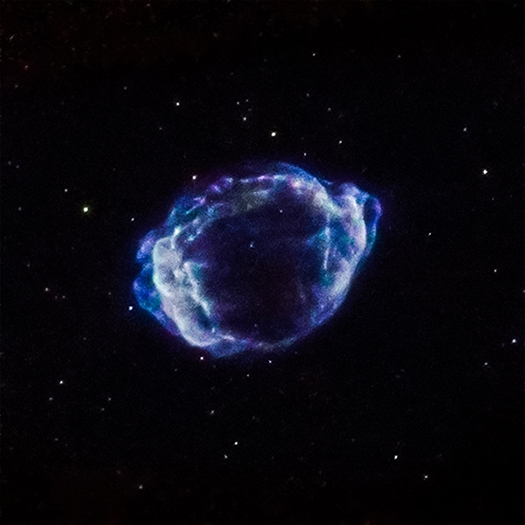Smaller Stars Pack Big X-ray Punch For Would-be Planets
Young stars much less massive than the Sun can unleash a torrent of X-ray radiation that can significantly shorten the lifetime of planet-forming disks surrounding these stars. This result comes from a new study of a group of nearby stars using data from NASA's Chandra X-ray Observatory and other telescopes.
Researchers found evidence that intense X-ray radiation produced by some of the young stars in the TW Hya association (TWA), which on average is about 160 light years from Earth, has destroyed disks of dust and gas surrounding them. These disks are where planets form. The stars are only about 8 million years old, compared to the 4.5-billion-year age of the Sun. Astronomers want to learn more about systems this young because they are at a crucial age for the birth and early development of planets.
Coding (and Coloring) the Universe

Micro to macro
Illustration: NASA/CXC/K.Divona
When people ask me what I do for work, I often say that I’m a storyteller. It’s not that I stand on a stage with a microphone and narrate long tales to a rapt audience.
My stories are told differently, not through voice or music, but through lines of code and technical applications. They are stories, of science.
As an undergraduate, I began my career in molecular biology, looking at the tiny organisms that can transmit Lyme disease to humans aboard the Ixodes Scapularis (a.k.a., the Deer tick). But by the time I graduated, I was moving on to learn about another type of science: that of computers.
Help Wanted: A Universe of Images

Images of our shared Universe provide snapshots of various phases of life and death, and different physical phenomena, found in locations across the cosmos. Modern telescopes allow us to “see” what the human eye cannot. This new generation of ground- and space-based telescopes has created an explosion of images for people everywhere to explore.
The Aesthetics & Astronomy project studies the perception of multi-wavelength astronomical imagery and the effects of the scientific and artistic choices in processing this astronomical data. The images come from a variety of space and ground-based observatories, including NASA’s Chandra X-ray Observatory and Hubble Space Telescope. Studies such as these can benefit astronomy across the electromagnetic spectrum of astronomical images, and may help visualization of data in other scientific disciplines.
Cosmic Genealogy: the Ancestors of Supermassive Black Holes

Fabio Pacucci
It is a pleasure to welcome Fabio Pacucci as a guest blogger. Fabio led the study that is the subject of our latest press release. He is going to defend his Ph.D. Thesis at the Scuola Normale Superiore in Pisa (Italy), under the supervision of Andrea Ferrara. During his Ph.D. he spent several months at the Institute d’Astrophysique de Paris (IAP) in France, Yale University and Harvard University in the USA. In September he is starting his first postdoctoral position at Yale University. Fabio has mainly been working on understanding the properties of the first black hole seeds, formed when the Universe was less than one billion years old.
It was a sunny and hot afternoon in Pisa when Andrea Ferrara, my Ph.D. supervisor, suggested that I study the first black holes formed in the Universe. This topic is among the most interesting in cosmology. We know that almost every galaxy hosts a supermassive black hole (SMBH) at its center. In the Milky Way there is a black hole about 4 million times more massive than the Sun, but objects up to 10 billion times the mass of the Sun have also been observed.
Chandra Movie Captures Expanding Debris From a Stellar Explosion
When the star that created this supernova remnant exploded in 1572, it was so bright that it was visible during the day. And though he wasn't the first or only person to observe this stellar spectacle, the Danish astronomer Tycho Brahe wrote a book about his extensive observations of the event, gaining the honor of it being named after him.
"Russian Doll" Galaxy Clusters Reveal Information About Dark Energy
We are happy to welcome Dr. Andrea Morandi as our guest blogger, who is giving us insight into his recent work on using galaxy clusters to investigate the nature of dark energy. Originally from Italy, Dr. Morandi received his Ph.D. in astronomy from the University of Bologna. Prior to his current position as a research assistant at the University of Alabama in Huntsville, Dr. Morandi was a post-doctoral fellow at the DARK Cosmology Center in Copenhagen and Tel Aviv University, followed by time as a research associate at Purdue University.

In 1998 and 1999 astronomers discovered the accelerating expansion of the Universe, providing evidence for the existence of the mysterious dark energy driving this acceleration. The same year I started to study astronomy at the Bologna University, fascinated by this major breakthrough in cosmology. I guess my interest for cosmology started from here.
Comets in the "X"-Treme
For millennia, people on Earth have watched comets in the sky. Many ancient cultures saw comets as the harbingers of doom, but today scientists know that comets are really frozen balls of dust, gas, and rock and may have been responsible for delivering water to planets like Earth billions of years ago.
Trigger for Milky Way's Youngest Supernova Identified
Scientists have used data from NASA's Chandra X-ray Observatory and the NSF's Jansky Very Large Array to determine the likely trigger for the most recent supernova in the Milky Way, as described in our latest press release.
Jupiter: Solar Storms Ignite 'Northern Lights' on Jupiter
Solar storms are triggering X-ray auroras on Jupiter that are about eight times brighter than normal over a large area of the planet and hundreds of times more energetic than Earth's 'northern lights,' according to a new study using data from NASA's Chandra X-ray Observatory. This result is the first time that Jupiter's auroras have been studied in X-ray light when a giant solar storm arrived at the planet.
Telescopes Combine to Push Frontier on Galaxy Clusters
Galaxy clusters are enormous collections of hundreds or even thousands of galaxies and vast reservoirs of hot gas embedded in massive clouds of dark matter, invisible material that does not emit or absorb light but can be detected through its gravitational effects. These cosmic giants are not merely novelties of size or girth - rather they represent pathways to understanding how our entire universe evolved in the past and where it may be heading in the future.






